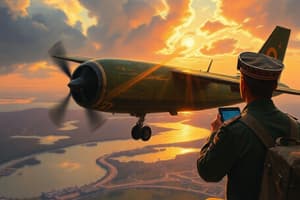Podcast
Questions and Answers
What is the main purpose of air navigation?
What is the main purpose of air navigation?
- To provide in-flight entertainment for passengers
- To determine and maintain the position and direction of an aircraft (correct)
- To control the air traffic on the ground
- To serve food and beverages to passengers
Which navigation system provides vertical and horizontal guidance to landing aircraft?
Which navigation system provides vertical and horizontal guidance to landing aircraft?
- Distance Measuring Equipment (DME)
- Global Positioning System (GPS)
- Instrument Landing System (ILS) (correct)
- VHF Omni-Directional Range (VOR)
What does the VHF Omni-Directional Range (VOR) system provide for pilots?
What does the VHF Omni-Directional Range (VOR) system provide for pilots?
- Distance and bearing from the transmitter (correct)
- Altitude information
- Speed of the aircraft
- Weather updates
Which system measures the distance between two points, such as a ground-based station and an aircraft?
Which system measures the distance between two points, such as a ground-based station and an aircraft?
What is the key function of the Global Positioning System (GPS) in aviation?
What is the key function of the Global Positioning System (GPS) in aviation?
Which system provides an omnidirectional radio beam from a ground station to help pilots navigate specific routes?
Which system provides an omnidirectional radio beam from a ground station to help pilots navigate specific routes?
What is dead reckoning in aviation navigation?
What is dead reckoning in aviation navigation?
What does true course navigation involve?
What does true course navigation involve?
How is radial navigation different from true course navigation?
How is radial navigation different from true course navigation?
Why is effective navigation crucial for pilots?
Why is effective navigation crucial for pilots?
What do pilots learn during navigation training?
What do pilots learn during navigation training?
Why do pilots undergo regular refresher courses?
Why do pilots undergo regular refresher courses?
Flashcards are hidden until you start studying
Study Notes
Air Navigation
Air navigation refers to the process of determining and maintaining the position and direction of an aircraft while in flight. This involves the use of various navigation systems and technologies to ensure safe and efficient air travel. Here are some key aspects of air navigation:
Navigation Systems
There are several types of navigation systems used by pilots to determine their location and track their route during a flight. These include:
-
VHF Omni-Directional Range (VOR): VOR is a radio navigation system that provides an omnidirectional radio beam from a ground station. It allows pilots to determine their distance and bearing from the transmitter, helping them navigate along specific routes.
-
Distance Measuring Equipment (DME): DME is an electronic system that measures the distance between two points, typically a ground-based station and an aircraft. It can be used in conjunction with VOR to provide more accurate distance information for pilots.
-
Instrument Landing System (ILS): ILS is a precision approach system that provides vertical and horizontal guidance to landing aircraft. It consists of a localizer, which provides lateral guidance, and a glideslope, which provides vertical guidance.
-
Global Positioning System (GPS): GPS is a satellite-based navigation system that provides precise location information to users. It is widely used in aviation for navigation, tracking, and communication purposes.
Navigation Techniques
Pilots use various navigation techniques to navigate their aircraft during a flight. These techniques may involve planning routes based on weather conditions and airspace restrictions, as well as monitoring aviation charts and reference materials. Some common navigation techniques include:
-
Dead Reckoning: Dead reckoning is the calculation of current position by measuring speed over time and knowing the initial heading and previous course. It involves estimating distance traveled along a given route by using information such as airspeed, wind direction, and elapsed time.
-
True Course Navigation: True course navigation involves navigating directly between two points without taking into account any deviations from a straight line path. This method assumes constant ground speed and requires frequent corrections to maintain the desired course.
-
Radial Navigation: Radial navigation involves following a radial, which is a line connecting the center of a radio beacon with its point on the Earth's surface. Pilots can determine their bearing relative to the radio beacon by tuning in the station and adjusting their aircraft's heading accordingly.
Importance of Navigation Training
Effective navigation is crucial for safe and efficient flight operations. Pilots undergo extensive training to learn how to navigate accurately using various systems and techniques. This includes studying aviation charts, understanding weather patterns, and practicing emergency procedures. Regular refresher courses help pilots stay up-to-date with new technologies and regulations related to air navigation.
Studying That Suits You
Use AI to generate personalized quizzes and flashcards to suit your learning preferences.



